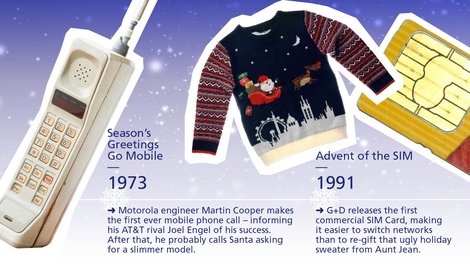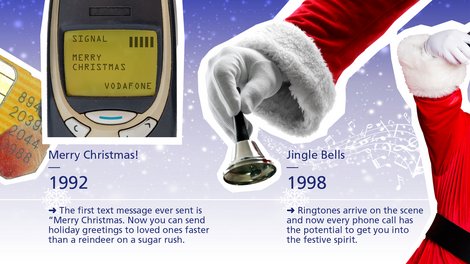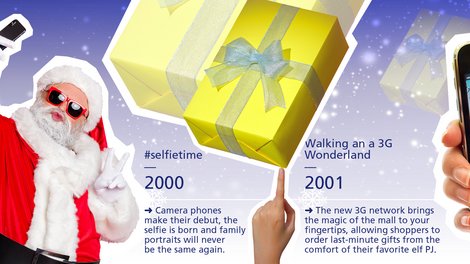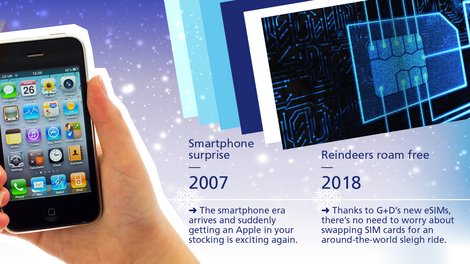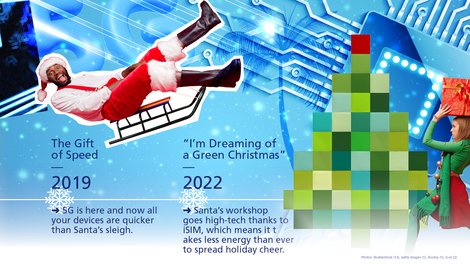Published: 21/12/2023

Calling home for Christmas
Fifty years after its invention, it’s hard to imagine life without a mobile phone. This holiday season, Spotlight reflects on the evolution of mobile technology and how it became such an important part of our lives – and of our festive celebrations.
Every holiday season, new festive songs are released in pursuit of a coveted Christmas number one. Usually, some of these songs achieve temporary hit status before eventually being relegated to the history books – only a special few survive the test of time. However, 50 years ago, in December 1973, not one but two instant classics were born: Slade’s “Merry Xmas Everybody” and Wizzard’s “I Wish It Could Be Christmas Every Day.” It was a vintage year for holiday hits.
And it was a memorable year not only for the music industry: technology was also booming. The Global Positioning System (GPS), which most people now rely on for everyday navigation, was developed by the US Department of Defense, and the Ethernet cable – a major milestone in the evolution of the internet – was also invented. And let’s not forget the Xerox Alto – the first desktop computer with a mouse and a graphical user interface.
However, one technological advancement stands above them all. One so groundbreaking that it would transform society on a global scale like few inventions before or since: the mobile phone.
And it has been quite a journey since then.
A history of mobile phones
The hidden hero behind mobile magic
Now half a century old, the mobile phone has gone from a luxury accessory to a universally owned device that has forever changed the way we live, work, and play. It is almost impossible to imagine life in today’s interconnected world without a mobile phone. Of course, the physical device is only one side of the story. Just as Santa cannot spread holiday joy without the tireless efforts of his elves working diligently behind the scenes, the limitless potential of mobile technology could never have been realized without the invention of another unsung hero: the SIM card.
Like mobile phones, the SIM card has undergone a significant makeover since it was first released to the market by G+D in 1991. However, while the hardware and capabilities of today’s eSIM and iSIM solutions are unrecognizable when compared with the earliest formats, the core function remains the same: to identify and authenticate a user’s subscription to the mobile network and to enable secure and reliable network connectivity.
In short, there is no mobile phone without the SIM card. And the festive period certainly would not be as fun either!
Just imagine the holidays without being able to …
- Video call relatives who live too far away to “drive home for Christmas”
- Discover new recipes that still don’t make Brussels sprouts edible
- Shop for holiday gifts – and secretly exchange unwanted gifts we receive
- Take family selfies in our ugly Xmas sweaters – and post them to Instagram, of course
- Track Santa’s journey around the world on a Santa-tracker app
- Play video games with the family – or online with friends
- Watch “Home Alone” for the 837th time
- Stream Wham!’s “Last Christmas” on repeat until Dad gets angry and throws his new Bluetooth speakers in the trash.
It simply doesn’t bear thinking about!
Fortunately, we don’t have to. Mobile and SIM technology are here to stay – and it’s only going to get better.

Unwrapping the future of mobile tech
Today’s hyper-connected world, where billions of devices are connected by a web of networks more intricate than a snowflake, bears little resemblance to that of 50 years ago. We’ve come a long way from just using our mobile phones to send generic holiday greetings to all our contacts.
Looking ahead to 2024, there are many exciting developments on the horizon. The adoption of 5G will continue to snowball as global network coverage improves and more compatible devices enter the market, making it easier than ever to stream the New Year’s Eve fireworks in crystal-clear resolution. In the consumer smartphone market, eSIM will also play an increasingly important role, making roaming easier for those who travel during the holidays. Meanwhile, the latest remote provisioning specifications will open up new opportunities for scaling in the IoT industry.
0 billion
the number of 5G connections expected by 2025
0+ million
the number of eSIMs sold by G+D
0+ billion
the number of SIM cards sold by G+D to mobile network operators since 1991
Beyond that, it’s hard to make too many bold predictions when technology moves faster than Santa’s sleigh on Christmas Eve. Will foldable or roll-up smartphones become the next big thing on everyone’s wish list? How long before smartphones are replaced by a completely new technology? What role will AI play in emerging connectivity trends – and can it at least settle the debate about whether “Die Hard” is a Christmas movie?
And, of course, the most important question at this time of year: what will be the next big holiday hit?
From the whole G+D Spotlight team, we wish you the happiest of holidays and the best possible start to the New Year.
Key takeaways
- The mobile phone has transformed society in the last 50 years – but it wouldn’t have been possible without the SIM card.
- eSIM and 5G adoption will continue to rise in the next few years, making it easier than ever to stream and roam.
Share this article
Subscribe to our newsletter
Don’t miss out on the latest articles in G+D SPOTLIGHT: by subscribing to our newsletter, you’ll be kept up to date on latest trends, ideas, and technical innovations – straight to your inbox every month.
